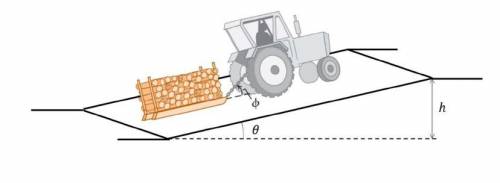
Physics, 18.03.2021 01:40 sunarafet3814
In the situation below, a tractor pulls a 850 sledge along a ramp with height ℎ = 1 and slope = 30 °. If the tractor applies a constant force to the sledge = 6750 , over an angle = 36.9 °, determine the total work performed by all forces on the sledge to move it along the ramp. The coefficient of kinetic friction between the sledge and the plane is = 0.3. Tip: for the calculation, remember that only the components of the forces that are parallel to the direction of displacement contribute to the work. Disregard the dimensions of the sled.


Answers: 2


Another question on Physics

Physics, 21.06.2019 17:30
The ballistic pendulum was invented in 1742 by english mathematician benjamin robins. it consists of an initially stationary pendulum that moves after being struck by a bullet, and it is used to measure the original velocity of the bullet. the known variables are the bullet's mass m, the pendulum's mass m, and the height to which the block and bullet swing, determined by the length of the pendulum l and final angle θ. two principles of physics are necessary to solve for the bullet's original velocity. what are these principles? conservation of momentum and newton's third law conservation of energy and conservation of angular momentum grade summary deductions 0% potential 100% conservation of momentum and newton's second law. newton's second law and conservation of angular momentum. conservation of energy and newton's third law conservation of momentum and conservation of angular momentum. conservation of momentum and conservation of energy conservation of energy and newton's second law.
Answers: 2

Physics, 21.06.2019 20:20
Aforce of 34n stretches a very light ideal spring 0.73 m from equilibrium, what is the force constant (spring constant) of the spring? (a) 47n/m (b) 38n/m (c) 53n/m (d) 25n/m
Answers: 3

Physics, 22.06.2019 11:30
With the simplified model of the eye, what corrective lens (specified by focal length as measured in air) would be needed to enable a person underwater to focus an infinitely distant object? (be careful-the focal length of a lens underwater is not the same as in air! assume that the corrective lens has a refractive index of 1.62 and that the lens is used in eyeglasses, not goggles, so there is water on both sides of the lens. assume that the eyeglasses are 1.90
Answers: 1

Physics, 22.06.2019 21:20
An electron is ejected into a horizontal uniform e⃗ field at a parallel horizontal velocity of v0. assume the electron's initial position x0, initial velocity v0, time t, magnitude of electric field e, electron's mass m, and the magnitude of the electron's charge |e|. ignore the force that earth exerts on the electron. assume the e⃗ field is in the same direction as the initial velocity. part a define the equation for the electron's velocity. express your answer in terms of the variables v0, |e|, t, e, and m.
Answers: 3
You know the right answer?
In the situation below, a tractor pulls a 850 sledge along a ramp with height ℎ = 1 and slope = 30 °...
Questions

English, 31.08.2019 15:00


Mathematics, 31.08.2019 15:00



Social Studies, 31.08.2019 15:00

Biology, 31.08.2019 15:00

History, 31.08.2019 15:00


History, 31.08.2019 15:00

Arts, 31.08.2019 15:00

Mathematics, 31.08.2019 15:00

Biology, 31.08.2019 15:00

Biology, 31.08.2019 15:00


History, 31.08.2019 15:00



Geography, 31.08.2019 15:00



